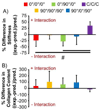Engineering meniscus structure and function via multi-layered mesenchymal stem cell-seeded nanofibrous scaffolds
- PMID: 25817333
- PMCID: PMC4442045
- DOI: 10.1016/j.jbiomech.2015.02.036
Engineering meniscus structure and function via multi-layered mesenchymal stem cell-seeded nanofibrous scaffolds
Abstract
Despite advances in tissue engineering for the knee meniscus, it remains a challenge to match the complex macroscopic and microscopic structural features of native tissue, including the circumferentially and radially aligned collagen bundles essential for mechanical function. To mimic this structural hierarchy, this study developed multi-lamellar mesenchymal stem cell (MSC)-seeded nanofibrous constructs. Bovine MSCs were seeded onto nanofibrous scaffolds comprised of poly(ε-caprolactone) with fibers aligned in a single direction (0° or 90° to the scaffold long axis) or circumferentially aligned (C). Multi-layer groups (0°/0°/0°, 90°/90°/90°, 0°/90°/0°, 90°/0°/90°, and C/C/C) were created and cultured for a total of 6 weeks under conditions favoring fibrocartilaginous tissue formation. Tensile testing showed that 0° and C single layer constructs had stiffness values several fold higher than 90° constructs. For multi-layer groups, the stiffness of 0°/0°/0° constructs was higher than all other groups, while 90°/90°/90° constructs had the lowest values. Data for collagen content showed a general positive interactive effect for multi-layers relative to single layer constructs, while a positive interaction for stiffness was found only for the C/C/C group. Collagen content and cell infiltration occurred independent of scaffold alignment, and newly formed collagenous matrix followed the scaffold fiber direction. Structural hierarchies within multi-lamellar constructs dictated biomechanical properties, and only the C/C/C constructs with non-orthogonal alignment within layers featured positive mechanical reinforcement as a consequence of the layered construction. These multi-layer constructs may serve as functional substitutes for the meniscus as well as test beds to understand the complex mechanical principles that enable meniscus function.
Keywords: Electrospinning; Mechanical properties; Meniscus; Nanofibrous scaffold; Tissue engineering.
Copyright © 2015 Elsevier Ltd. All rights reserved.
Conflict of interest statement
The authors have no disclosures or conflicts of interest to report.
Figures








References
-
- Ahmed AM, Burke DL. In-vitro measurement of static pressure distribution in synovial joints--part i: Tibial surface of the knee. J Biomech Eng. 1983;105(3):216–225. - PubMed
-
- Aufderheide AC, Athanasiou KA. Assessment of a bovine co-culture, scaffold-free method for growing meniscus-shaped constructs. Tissue Eng. 2007;13(9):2195–2205. - PubMed
Publication types
MeSH terms
Substances
Grants and funding
LinkOut - more resources
Full Text Sources
Other Literature Sources

